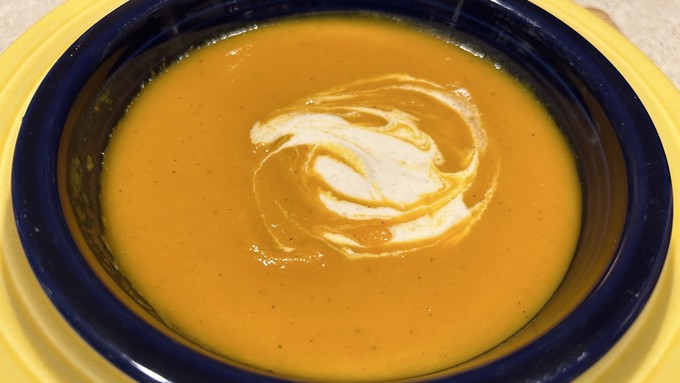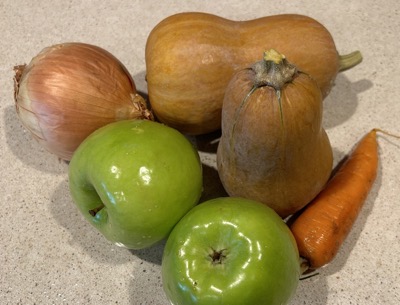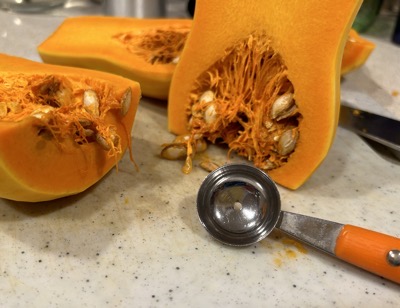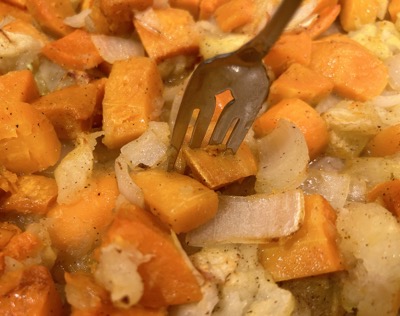
Recipe: Roasting squash increases the depth of flavor

Warm, filling and good for you, too: The only dairy in this soup is in that optional swirl. Kathy Morrison
We're down to the last few days of autumn (officially). And it's going to rain this week, just as the final pre-Christmas rush takes hold. If you're looking to cook something easy and warming in the meantime, I have the answer: Roasted butternut-apple soup.

This soup is all in the prep: Lots of peeling and some chopping. But once everything is in the oven to roast, the bulk of the work is over. Just blend the roasted vegetables and apples with vegetable or chicken broth, adjust the seasonings and boom! A great dinner or lunch for 6 or 8 people, appetizer for more, or plenty to freeze for later. No butter or other dairy is needed to make it creamy.
This soup takes well to all types of garnishes, too. I added a swirl of lightly spiced yogurt, but chopped herbs, roasted nuts or pepitas, or bits of crisp bacon all are possibilities.
On the squash: I used several of my homegrown Honey Nut squashes, which are smaller and a bit sweeter than butternuts. (See this Honey Nut recipe from earlier in the fall.) But either works well. Or try Kabocha squash, which will yield a darker orange soup. But the apples need to be tart ones, to counteract the squash's sweetness, so I chose the ubiquitous Granny Smiths.
The cayenne gives the soup just a slight kick -- it doesn't take over -- but leave it out or substitute with garlic powder if you prefer.
Roasted butternut-apple soup
Serves 6 to 8
Ingredients:

2-1/2 to 3 pounds butternut, Honey Nut or Kabocha squash (weight before trimming and peeling)
2 tart apples, such as Granny Smiths
1 large yellow or white onion
1 carrot
2-1/2 tablespoons olive or grapeseed oil (I use a blend of both)
1 teaspoon kosher salt
1/2 teaspoon ground black pepper
1/4 teaspoon cayenne pepper, optional
3-1/2 to 4 cups vegetable or chicken broth, homemade or a low-sodium store brand
1/4 teaspoon sweet paprika, optional
Yogurt garnish, optional:
1/2 cup plain Greek yogurt
1/2 tablespoon maple syrup
Generous pinch of grated nutmeg
Alternatives for garnish: Croutons, toasted walnuts, toasted pepitas, chopped sage or parsley, bits of crispy bacon
Instructions:
Heat oven to 425 degrees F. Prepare a large sheet pan by lining it with parchment paper.

Trim, peel and deseed the squashes, then cut into approximately 1-inch cubes. You should have about 6 cups of cubes.
Peel, core and chop the apples into large chunks. Trim and roughly chop the onion and the carrot.
Put the vegetables and apples into a large bowl. Pour the oil over the mixture, and stir with a spatula until the oil is well distributed.
Sprinkle the 1 teaspoon salt, the ground black pepper and the cayenne (if using) over all, stir to combine, then pour everything into the prepared sheet pan. Spread out the cubes so they're in as much of an even layer as possible, then put the pan in the oven.
Roast for 20 minutes, then stir the vegetable-apple mixture. Check the tenderness of the vegetables at this point using a fork. Bake at least 10 more minutes, or until everything starts to brown and the squash and carrots are perfectly tender. Remove from oven and allow to cool for a few minutes.
Scrape the vegetables into a large Dutch oven or soup pot. Add 2 cups of the broth and bring to a simmer over medium heat. Add 1-1/2 cups more of broth. At this point you can blend the soup in the pot if you have an immersion blender, or remove it to a standard blender in batches then return to the pot. (Careful that it's not too hot! Hot soup in a blender is a disaster waiting to happen.)
Taste and adjust the seasonings. I added the paprika at this point, and a bit more salt, but trust your own palate. Add another 1/2 cup of broth if it still seems too thick. Heat through to serving level. Serve in bowls or cups, garnished as desired.
To make the yogurt garnish: Thin the yogurt with the maple syrup, and stir in the nutmeg. Dollop each bowl with a spoonful, and swirl it with a knife.
This soup is spectacular served with warmed slices of good bread. Sausages, cheese or ham are also good accompaniments, either on sandwiches or on their own.
Comments
0 comments have been posted.Sacramento Digs Gardening to your inbox.
Sites We Like
Garden Checklist for week of July 21
Your garden needs you!
* Keep your vegetable garden watered, mulched and weeded. Water before 8 a.m. to reduce the chance of fungal infection and to conserve moisture.
* Feed vegetable plants bone meal, rock phosphate or other fertilizers high in phosphate to stimulate more blooms and fruiting. (But wait until daily high temperatures drop out of the 100s.)
* Don’t let tomatoes wilt or dry out completely. Give tomatoes a deep watering two to three times a week.
* Harvest vegetables promptly to encourage plants to produce more. Squash especially tends to grow rapidly in hot weather. Keep an eye on zucchini.
* Pinch back chrysanthemums for bushy plants and more flowers in September.
* Remove spent flowers from roses, daylilies and other bloomers as they finish flowering.
* Pinch off blooms from basil so the plant will grow more leaves.
* Cut back lavender after flowering to promote a second bloom.
* It's not too late to add a splash of color. Plant petunias, snapdragons, zinnias and marigolds.
* From seed, plant corn, pumpkins, radishes, winter squash and sunflowers.